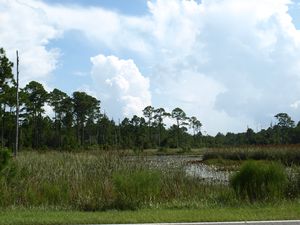Posted in Gardening | 1 Comment »
If you are interested in gardening (why else are you here?) and the science behind gardening, The Garden Professors is exactly what you want. They – a group of horticulture professors from several states – post frequent and highly interesting articles. This past week has covered every thing from possible hazards of compost tea to the LD50 of coffee to a review of a classic organic gardening book. Every Friday there is a puzzle – usually on what went wrong with a plant. If you’re looking for a challenge, try these out.
Posted in Gardening | Tagged blogs, Cooperative Extension, horticulture, plant science, university | 4 Comments »
-
block BPA damage, even in the face of significant exposure, by giving pregnant animals extra folate (found mostly in green leafy vegetables – foliage – such as spinach) or extra genistein (found mostly in legumes such as soy).
Posted in Gardening | Tagged bookmarks, fertilizer, food, soil | Leave a Comment »
I have 3 new fact sheets up at my workplace website. Take a look:
Pretty pictures too. And yes, this does mean it’s time for me to pay attention to this blog again. I’ve neglected it for far too long.
Posted in Gardening, Shrubs, trees | Tagged Gardening, Shrubs, trees | 3 Comments »
Posted in Gardening | Tagged bookmarks, botany, horticulture, libraries | Leave a Comment »
-
“This publication discusses using solitary or native bees as pollinators. Some of the larger groups of bees are discussed, including alkali bees, leafcutter bees, alfalfa leafcutter bees, bumblebees, sweat bees, squash bees, digger bees, orchard mason bees, shaggy fuzzyfoot bees, and hornfaced bees. Information is also presented on how to attract and conserve populations of wild bees for pollination purposes. There is also a list of suppliers of native bees and bee equipment.”
-
Colony collapse disorder (CCD) or sometimes honey bee depopulation syndrome (HBDS)[1] is a phenomenon in which worker bees from a beehive or European honey bee colony abruptly disappear.
-
The USDA-ARS sponsors five bee research labs at:
Baton Rouge, Louisiana
Beltsville, Maryland
Logan, Utah
Tucsan, Arizona.
Weslaco, Texas
Each lab is listed below with its home-page, mission, and a link to associated research summaries. -
Bees and other pollinators are important to our environment, providing essential services for the production of more than two-thirds of the world’s crop species. ,,,
But, pollinators are in trouble.
Posted in Gardening | Tagged bees, beneficial insects, entomology, insects, pollination, pollinators | 1 Comment »
Thanksgiving in the FL Panhandle. Yeah…..
But, isn’t the grandmother who’s supposed to live in FL, not the daughter and granddaughter?
Posted in Gardening | Tagged Florida, Thanksgiving, vacation | 5 Comments »
I got waved! And now I’m dealing with newbie confusion, but think this will be helped by having other like minded folk to wave at. So if your one of the lucky early Google Wave invitees, I’ve started a wave directory for anyone related to gardening, horticulture, landscaping, botany or other plant lovers in general. If you’re as confused as I am, lets be confused about gardening together.
Posted in Gardening | Tagged gardeners, google wave, horticulturists, tech | 3 Comments »
Early this past week, near where I live, a 10 month old baby died, and his mother and 2-year-old brother were seriously sickened, almost certainly by pesticide exposure.
In brief, a young mother, with 2 young children moved into a single wide trailer. It was apparently all she could afford, and infested with roaches. She attempted to control them with “bug bombs” before moving in, but the problem persisted. Later, while living there, she continued to use “bug bombs” to combat the continuing problem, to the extent of greatly exceeding the recommended application rate and frequency. She may or may not have used proper methods. Her youngest developed breathing problems, she called 911, but the baby died. Later while visiting the 2-year-old in the hospital, the mother became ill, had to be admitted, and was moved to the ICU and placed on a ventilator. As far as I know this is where the matter stands. Final results from the toxicology labs are not expected for weeks.
Reactions across the region and nation in internet news article comments I’ve read have been mixed. Most news article comments have been highly emotional, either expressing great sympathy for the mother, or anger and blame at her actions.
My own emotional reaction to this situation has been incredibly muddled, and I’ve delayed posting this long because of that. I’m still not clear. I feel sorrow for the baby. Sorrow and sympathy for the mother and surviving child. Anger at the mother. Anger at the pesticide companies. I also feel a certain sense of personal failure. As illogical as that is, I suspect it’s not uncommon among people like me, who spend a fair amount of their work hours trying to teach people how to deal with pest problems safely and effectively. This whole situation is certainly a horrible failure in understanding of safe pest management and pesticide use .
There are a number of issues that haven’t been addressed in the commentary I’ve read so far. Most of that focused on the issue of the mother’s personal responsibility. Very little has brought up the issue of corporate responsibility, television advertisement as a source of information, labeling practices, public understanding of how to deal with pests or our cultural expectations of easy fixes.
While pesticide labels by regulation must contain pretty full information on how use pesticides as safely as possible, they are often extremely difficult to read. Pesticide companies actually print labels for separate states, using whatever is the minimum font size required by that state. I’ve seen labels with colors that seem deliberately designed to make reading difficult. A medium to light green on a beige background I saw a few years ago seemed designed both for difficult reading and to give the (false) impression that the pesticide was a “green” product. Labels seem to rarely be written for ease of comprehension.
Many people I talk to put great reliance on what they have seen on television (even in paid advertisements), or what they have seen in a store as reliable sources of information. This seems to be a lack of critical thinking skills, a lack of education in evaluating information validity. It is hard to learn these ways of thinking if one reaches adulthood without them. With information bombarding us from all sides, within a more and more rapidly changing world, these skills are essential. How many people have the skills to distinguish the marketing promise of simple, instant satisfaction pest eradication, from the actual pesticide label instructions and warnings? Which has more effect on their behavior?
Most people want easy ways to deal with problems. We’ve come to expect in 21st century America that there is a simple cure in a bottle or jar for everything. With health issues, we see this in the preferred use of drugs to deal with disorders such as adult-onset diabetes, high cholesterol, high blood pressure that would often be more effectively prevented or dealt with by lifestyle changes, diet, etc. With pests, there is the same belief that a magic pill will cure all troubles. Cultural methods, exclusion, cleanliness, etc. just seem too difficult compared to an easy promise on a bright bottle.
How much of this lead to tragedy for a small South Carolina family?
Posted in Gardening | Tagged bug bombs, cockroaches, insecticides, pest management, pesticide safety, pesticides, roaches | 10 Comments »
Leaf color seemed to be more advanced in Spartanburg than in Clemson or Anderson, only about 60 miles away and about the same elevation. hmmm. So, a bit past peak, but still lovely. I only spent a couple of hours there, since it turned out to stay so wet and cold. Next year I’ll know to go earlier, before peak hits here. I’d still recommend the trip now since lots of trees are still coloring and even when I’ve been mid-winter, the arboreta are still terrific collections. Woffard and Milliken worked with Michael Dirr on establishing their collections. If you have someone who knows Spartanburg along, it would help find places. (I find SpB very confusing, my SpB native coworker says not. Wonder why?)
So, some pics, with a few more later when I have more time.
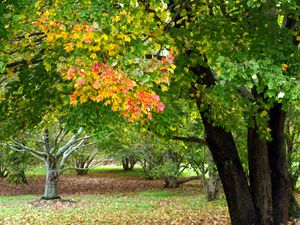
Red maple (Acer rubrum)
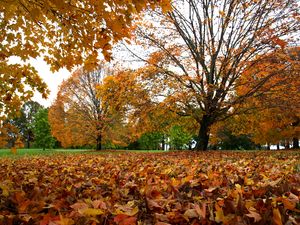
‘Legacy’ Sugar Maple (Acer saccharum ‘Legacy’)
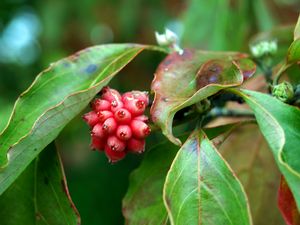
‘Constellation’ dogwood (Cornus x ‘Constellation) berries
This is a hybrid between C. florida and C. kousa. It really shows in the intermediate appearance of the berries. This series (Stellar dogwoods) is alleged by some not to fruit.
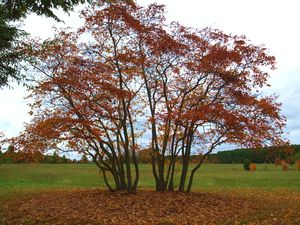
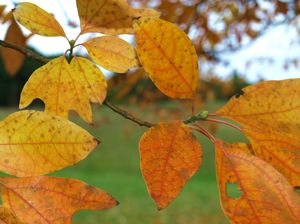
Sassafras (Sassafras albidum) colony and leaves
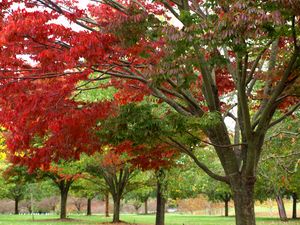
‘Halka’ Zelkiova (Zelkova serrata ‘Halka’)
These trees seemed a bit divided on the issue of turning or not.
And lastly for now, Mystery Fungus.
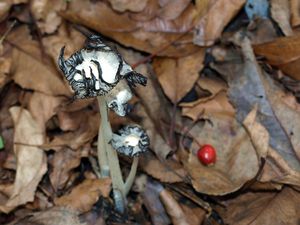
Cute little thing. Hordes of them were growing under a crabapple tree. Does anyone know what it is?
Posted in trees | Tagged fall, fall color, spartanburg, trees | 6 Comments »

